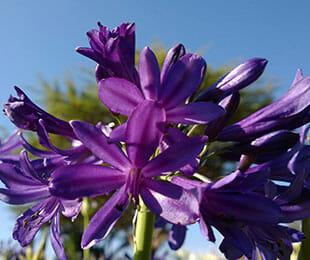Agapanthus Buddy Plant Kingdoms: Perfect Pairings for Your Yard
Understanding the Art of Agapanthus Care: Essential Steps for Healthy And Balanced Development and Lively Blooms
In the realm of horticulture, the growing of agapanthus stands as a fulfilling undertaking for those who seek to nurture these stylish flowering plants. From picking the ideal range to mastering pruning strategies, the journey in the direction of cultivating growing agapanthus plants is diverse and holds the vital to unlocking the full capacity of these organic gems.

Choosing the Right Agapanthus Variety

When selecting the right Agapanthus range for your yard, take into consideration variables such as environment viability, bloom color, and growth habit. Agapanthus, commonly understood as Lily of the Nile or African lily, is available in a range of colors ranging from shades of blue and purple to white. Select a flower shade that complements your existing garden palette to create an unified landscape. In addition, take into consideration the environment in your area to make sure the Agapanthus variety you choose can flourish in your particular conditions. Some ranges are much more tolerant of cool temperature levels, while others like warmer environments. Comprehending the growth habit of various Agapanthus varieties is vital for appropriate placement within your yard. Some ranges have a clumping development routine, perfect for boundaries or containers, while others have an even more spreading nature, appropriate for ground cover or mass growings. By carefully assessing these elements, you can choose the best Agapanthus selection to improve the beauty of your yard.
Ideal Growing Conditions
Considering the optimal ecological needs is essential for successful Agapanthus growing. Agapanthus plants are delicate to chilly temperature levels and need to be protected from frost during wintertime months.
To make certain healthy growth and vibrant blooms, plant Agapanthus light bulbs at a depth of about 2-4 inches and space them 8-12 inches apart. Mulching around the base of the plants assists maintain dampness and reduces weed development.
Watering and Fertilizing Tips
Maintaining correct dampness levels and providing crucial nutrients are essential elements in the treatment regimen for Agapanthus plants. When it comes to sprinkling Agapanthus, it is vital to strike a balance. These plants prefer constantly wet dirt yet are at risk to root rot if overwatered.
Fertilizing Agapanthus is necessary for promoting healthy and balanced development and prolific blooms. Apply a balanced fertilizer, such as a 10-10-10 formula, in the very early spring as brand-new development arises. Repeat this application every 6-8 weeks throughout the growing period. Avoid excessive fertilizing, as it can bring about rich vegetation at the expenditure of blooms. Constantly comply with the supplier's instructions for proper dilution and application techniques. By adhering to these read here watering and feeding tips, you can ensure your Agapanthus plants flourish and create vivid, long-lasting blooms.
Trimming Techniques for Agapanthus
Trimming straight from the source Agapanthus plants at the proper times and with correct techniques is essential for preserving their health and promoting optimum growth and flowering. The excellent time to trim Agapanthus is in late winter season or early spring before brand-new growth arises.
Deadheading spent flowers can likewise redirect the plant's energy right into generating more blossoms rather than setting seeds. If you want to collect seeds for propagation, leave some flowers to dry and mature on the plant.
Keep in mind to make use of tidy, sharp devices to make accurate cuts and decrease the danger of presenting illness. Agapanthus. Routine pruning will help maintain your Agapanthus looking healthy and neat while making sure an abundant display screen of gorgeous flowers
Managing Common Pests and Diseases
After making sure appropriate pruning strategies for Agapanthus, it is important to deal with common bugs and conditions that can impact the health and wellness and vitality of these plants. One typical pest that impacts Agapanthus is the Agapanthus gall midget.
Furthermore, Agapanthus plants can suffer from root rot if they are grown in inadequately draining soil. By being cautious and taking prompt action versus illness and bugs, you can help your Agapanthus plants flourish and produce vivid blooms. Agapanthus.

Verdict
In conclusion, grasping the art of agapanthus care entails selecting the appropriate variety, supplying perfect growing problems, proper watering and fertilizing, proper trimming techniques, and attending to typical bugs and diseases. By complying with these crucial steps, you can guarantee healthy development and lively blooms for your agapanthus plants. Bear in mind to on a regular basis keep an eye on and preserve your plants to promote their general health Going Here and longevity.
To guarantee healthy and balanced development and dynamic flowers, plant Agapanthus light bulbs at a depth of regarding 2-4 inches and room them 8-12 inches apart. By adhering to these watering and feeding pointers, you can ensure your Agapanthus plants thrive and produce dynamic, lasting blossoms.
One usual pest that influences Agapanthus is the Agapanthus gall midget. Additionally, Agapanthus plants can endure from origin rot if they are planted in poorly draining pipes soil. By complying with these essential steps, you can guarantee healthy and balanced development and lively blossoms for your agapanthus plants.